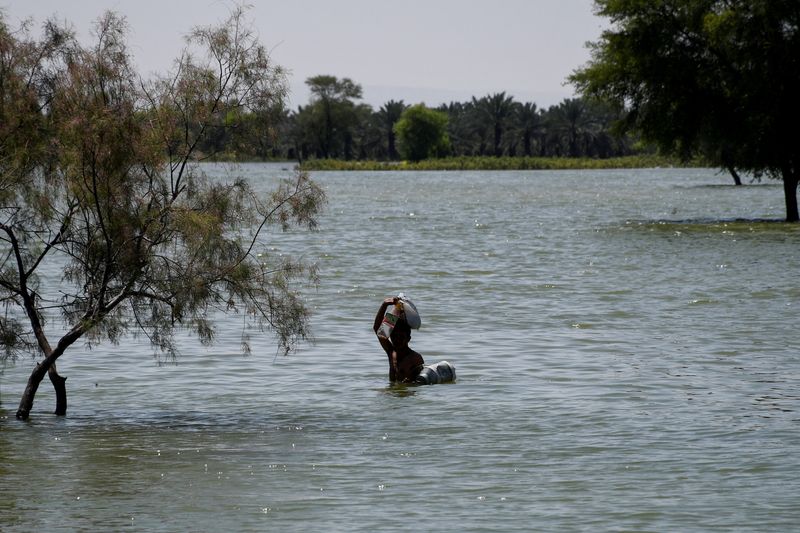South Pakistan braces for surge of flood water flowing from north
2022.09.01 12:29

FILE PHOTO: A flood victim wades through flood water, following rains and floods during the monsoon season in Bajara village, Sehwan, Pakistan, August 31, 2022. REUTERS/Yasir Rajput
By Syed Raza Hassan and Asif Shahzad
DADU, Pakistan (Reuters) – Southern Pakistan braced for more flooding on Thursday as a surge of water flowed down the Indus river, compounding the devastation in a country a third of which is already inundated by a disaster blamed on climate change.
Record monsoon rains and melting glaciers in northern mountains have triggered floods that have killed at least 1,191 people, including 399 children.
The United Nations has appealed for $160 million to help with what it has called an “unprecedented climate catastrophe”.
“We’re on a high alert as water arriving downstream from northern flooding is expected to enter the province over the next few days,” the spokesman of the Sindh provincial government, Murtaza Wahab, told Reuters.
Wahab said a flow of some 600,000 cubic feet per second was expected to swell the Indus, testing its flood defences.
Pakistan has received nearly 190% more rain than the 30-year average in the quarter from June to August, totalling 390.7mm (15.38 inches).
Sindh, with a population of 50 million, has been hardest hit, getting 466% more rain than the 30-year average.
Some parts of the province look like an inland sea with only occasional patches of trees or raised roads breaking the surface of the murky flood waters.
Hundreds of families have taken refugee on roads, the only dry land in sight for many of them.
Villagers rushed to meet a Reuters news team passing along one road near the town of Dadu on Thursday, begging for food or other help.
The floods have swept away homes, businesses, infrastructure and roads. Standing and stored crops have been destroyed and some two million acres (809,371 hectares) of farm land inundated.
The government says 33 million people, or 15% of the 220 million population, have been affected.
The National Disaster Management Authority said some 480,030 people have been displaced and are being looked after in camps but even those not forced from their homes face peril.
“ More than three million children are in need of humanitarian assistance and at increased risk of waterborne diseases, drowning and malnutrition due to the most severe flooding in Pakistan’s recent history,” the U.N. children’s agency warned.
The World Health Organization said that more than 6.4 million people were in dire need of humanitarian aid.
Aid has started to arrive on planes loaded with food, tents and medicines, mostly from China, Turkey and United Arab Emirates.
Aid agencies have asked the government to allow food imports from neigbouring India, across a largely closed border that has for decades been a front line of confrontation between the nuclear armed rivals.
The government has not indicated it is willing to open the border to Indian food imports.
(Writing and reporting by Asif Shahzad in Islamabad; Editing by Robert Birsel)








